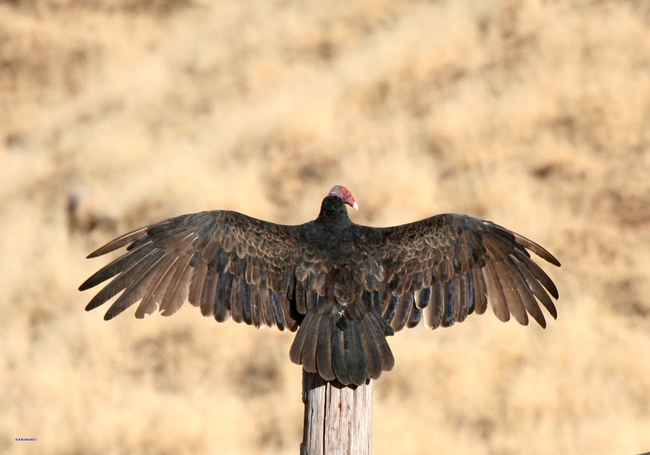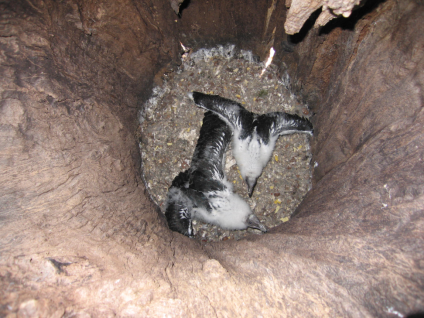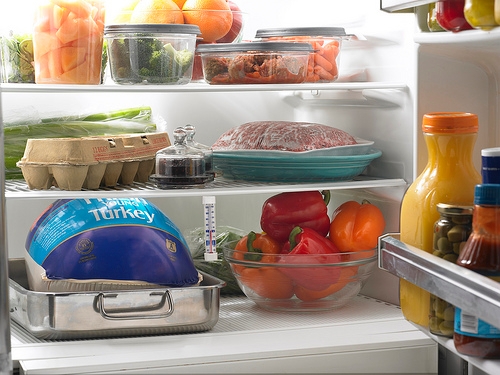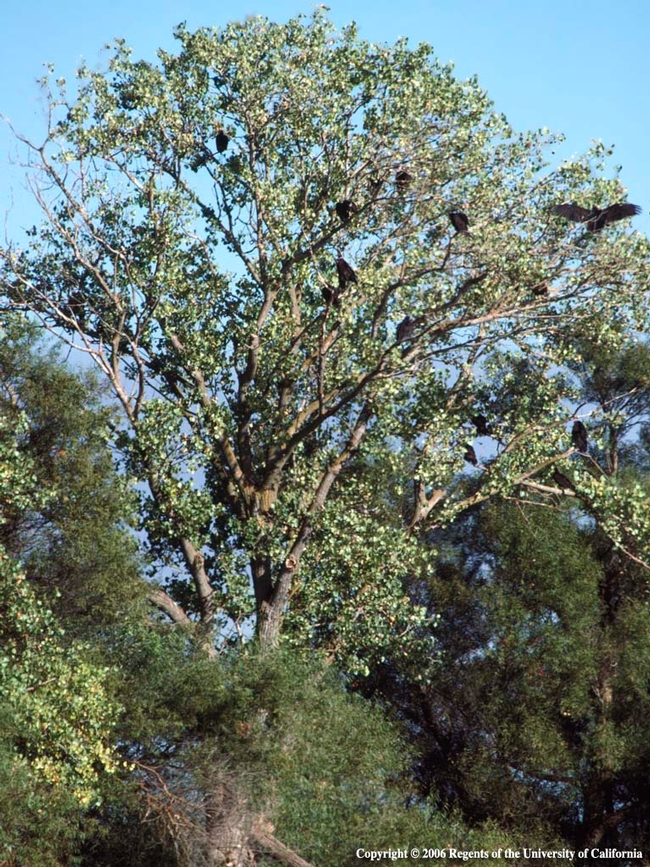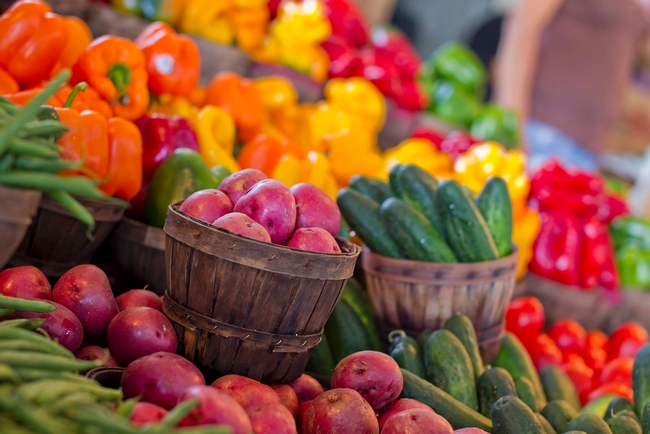Posts Tagged: turkey
Turkey vultures have peculiar nesting habits, study finds
Omnipresent and homely, turkey vultures are a native California wildlife species that doesn't get a lot of research attention.
But UC Cooperative Extension advisor Greg Giusti has found a surprising level of interest from the public in his Northern California research project about turkey vultures' nesting preferences in oak woodland.
“Animals with cute fuzzy faces are far more attractive in our culture,” said Giusti, a wildland ecology expert. “Turkey vultures have been overlooked. Very little is known about their biology and environmental needs.”
Giusti worked with Robert Keiffer, superintendent of the 5,300-acre UC Hopland Research and Extension Center in Mendocino County, to better understand the nesting habits of the red-faced scavengers.
In the study area, the researchers counted 417 trees in all; seven of them had suitable nesting elements for turkey vultures. They found that the vultures at the Hopland facility select large hollow trees – either dead or alive, either shaded or in the sun – to lay eggs and rear their young. The tree species in the study included blue oak, interior live oak, Oregon white oak and valley oak.
The nesting trees were widely dispersed and ranged in diameter from 36 inches to 65 inches around at breast height. The nesting cavities are vertical tubes in the tree trunks that drop down as much as 13 feet from the entrance to the ground.
“This is very different from other large birds, like eagles and osprey, who build open cup nests high up in tall trees, which they may use for generations,” Giusti said.
After turkey vulture chicks hatch, the parents drop into the cavity five or six times a day to feed their young, Giusti said. How birds with a five-foot wingspan traverse a deep vertical tunnel is a mystery.
“They just shimmy up and down, I would imagine,” Giusti said. “We don't know how the young birds do it when they fledge. We've never witnessed the adult birds calling them out.”
Giusti said the scientists will continue to build on the turkey vulture nesting database they have started with results from this project. In the coming years, they hope to learn whether turkey vultures will re-use successful nesting sites and whether they may be found nesting in fallen logs or rock piles.
In the video clip below, a turkey vulture explores a possible nesting cavity at the UC Hopland REC.
An initiative to maintain and enhance sustainable natural ecosystems is part of the UC Division of Agriculture and Natural Resources Strategic Vision 2025.
Avoid misgivings about food safety at Thanksgiving
I am a terrible cook. My brother is an excellent cook. One year he told me his turkey was thawing in the bathtub because it was too big for the refrigerator and my enthusiasm for dining at his house began to cool.
“The prevention plan for food safety begins with planning the feast, knowing when a frozen turkey needs to start defrosting in the refrigerator so there is ample time to thaw,” says Connie Schneider, director of UC Agriculture and Natural Resources Youth, Families and Communities Statewide Program. “What size turkey will you defrost? Is there enough space to thaw the turkey safely?”
To avoid making diners sick, the traditional fowl should be thawed at temperatures below 40 degrees F. The "Danger Zone," temperatures where foodborne bacteria multiply rapidly, is between 40 and 140 degrees F.
“People thaw on the counter, they put their turkeys in the garage to thaw out,” says Schneider, in a “can you believe there are such fools?” tone that warns me that I should not admit to doing this. “They also place dinner leftovers, especially the big turkey, in the garage because of lack of refrigerator space.”
The registered dietitian advises, “When using refrigerator thawing, place the turkey in its original wrapping placed in a pan, which prevents dripping as turkey defrosts.”
A whole turkey weighing 4 to 12 pounds takes 1 to 3 days to thaw in a refrigerator. Heavier turkeys take longer. A thawed turkey can remain in the refrigerator for 1 or 2 days before cooking.
If your turkey weighs more than 12 pounds and today is Tuesday and you haven’t begun thawing it, you may have to resort to Plan B for thawing the bird or ordering Chinese food on Thursday.
According to the USDA Food Safety and Inspection Service website, there are three safe ways to thaw food: in the refrigerator, in cold water and in the microwave oven. Procrastinators will be thawing their birds in cold water or in the microwave. For details on quicker thawing, see the USDA website: http://www.fsis.usda.gov/wps/portal/fsis/topics/food-safety-education/get-answers/food-safety-fact-sheets/poultry-preparation/turkey-basics-safe-thawing/ct_index.
Schneider also reminds us to prevent cross-contamination of foods. For example, don’t wash or rinse the turkey before cooking because the rinse water may splash bacteria around the sink, which can then come into contact with other foods and utensils. Another way to prevent cross-contamination is prepping the stuffing ingredients before you handle the raw turkey. Keep the raw turkey and their juices away from other foods. After you prep your raw turkey, wash the cutting board, knife, sink and counter tops with hot, soapy water. Sanitize cutting boards with a solution of 1 tablespoon of unscented, liquid chlorine bleach in 1 gallon of water. Wash your hands with soap and warm water frequently and always after handing raw foods. And for crying out loud (to invoke a phrase my late father used), don’t wipe your dirty hands on a towel that will be used to dry clean dishes later!
Planning is also needed for storing leftover food after the meal, cautions Schneider. “Everyone loves leftovers, but make sure you have adequate refrigeration space.”
She recommends wrapping leftovers in airtight packaging or sealing in storage containers. This helps keep out bacteria while keeping your food moist and preventing your prized family dishes from picking up odors from other foods being stored in the fridge. For faster cooling, break up large amounts of food into smaller containers.
“Toss out any food that has been left out for more than 2 hours at room temperature!” Schneider admonishes. “Don’t allow your turkey to sit out, slice up the leftovers and refrigerate or freeze them right after your meal!”
Delicious leftovers that have been stored in the refrigerator can be enjoyed for 3 to 4 days. If you freeze them, you can eat them 3 or 4 months from now.
This Thanksgiving, I will be thanking God for allowing my family and me to survive our lackadaisical food handling on previous holidays. Happy Thanksgiving to you and your loved ones!
For more information on food safety, visit http://www.fsis.usda.gov/wps/portal/fsis/topics/food-safety-education/get-answers/food-safety-fact-sheets/safe-food-handling/keep-food-safe-food-safety-basics/ct_index.
'Overlooked' turkey vultures the center of UCCE research
To some, turkey vultures are repugnant scavengers that feed on road kill. But to Greg Giusti, they are an intriguing, unexplored scientific topic, said an article in the Ukiah Daily Journal.
"They aren't warm and cuddly so people aren't drawn to them," Giusti said. "My academic curiosity drew me in."
Giusti has discovered that the birds nest in cavities of old, long-dead oak trees.
"We have seen the vultures jump inside the hollow, the middle of the tree, some 8 to 10 feet down," Giusti said. "Since there is not sufficient diameter for them to fly up from the inside, we surmise that they shimmy up to the top. When the hatchlings are about a month old and able to fly, almost full size, they, too, must shimmy up to get out."
The UC Hopland Research and Extension Center hosts a public seminar, "Turkey Vultures in the Oaks: A Lovely Yet Maligned Bird," at 7 p.m. tonight in the Rod Shippey Hall, 4700 University Road, Hopland.
What's in your compost?
For home gardeners, spring is a busy time of year and there’s never a tomato with more flavor than one grown to full ripeness on the vine. But there are also many safety precautions to follow to prevent contamination of fruits and vegetables with pathogens that cause serious food-borne illnesses.
Michele Jay-Russell, a veterinarian and research microbiologist at the Western Institute for Food Safety and Security (WIFSS) and program manager of the Western Center for Food Safety (WCFS), recently co-authored a study that highlights the need to be aware of the hazards associated with using raw animal manure to fertilize home gardens. (Read full article here.)
The basis for the study began in July of 2010 when a shire mare from a rural Northern California farm was brought to the William R. Pritchard Veterinary Medical Teaching Hospital for treatment of colic. Following protocol, the veterinarians on call screened the horse for Salmonella to avoid infecting other horses during hospitalization. She tested positive and after successful treatment for colic, went home. Her owners then notified the veterinarians that some of their other draft horses were sick as well — all 8 were tested and 6 came back positive for the same Salmonella Oranienburg strain, including the mare that still had the infection.
Jay-Russell heard about the case from her colleague John Madigan, professor of medicine and epidemiology at the school. The farm’s owners invited Jay-Russell and Madigan to the farm to see if they could uncover the source of the Salmonella infection. They sampled water from horse troughs, manure storage piles, wild turkey feces and soil from the family’s edible home garden where raw horse manure had been used as fertilizer. Each of those locations had a percentage of positive samples over the sampling period from August 2010 to March 2011.
“We showed the owners how to continue collecting samples and provided them with a FedEx number to ship them to UC Davis,” Jay-Russell said. “During that whole time, the garden soil kept coming back positive, which showed that this strain of Salmonella could persist for months.”
While the researchers couldn’t be completely certain about the original source of Salmonella on the farm, they suspect that a recent surge in the wild turkey population on the property introduced the bacteria to the horses by pooping in the horse corrals and in the water troughs. They speculated that the wild turkeys brought the Salmonella onto the property, although they couldn’t rule out the possibility that the birds were exposed on the farm or to other potential sources of Salmonella.
“What is clearer is that the raw horse manure applied as fertilizer was the most likely source of garden soil contamination,” Jay-Russell explained. “We suspect that the damp climate in Mendocino County may have contributed to the longevity of this bacterium in the soil long after the owners stopped applying the horse manure to the garden. Fortunately, the owners didn’t get sick, but our investigation showed the potential for widespread dissemination of Salmonella in a farm environment following equine infection.”
To promote safe gardening practices, Jay-Russell has teamed with Trevor Suslow, a Cooperative Extension food safety specialist in the Department of Plant Sciences, to speak to groups of small farmers around the state about best practices. They also use a brochure in English and Spanish, “Food Safety Tips for Your Edible Home Garden,” that includes information about safe uses of animal manure and ways to minimize animal fecal contamination.
“It’s good to let people know about the risks and to correct misinformation about ways to treat the compost pile before using it in the garden,” Jay-Russell said. “The biggest take home message from this experience is to be very careful about using manure from sick horses — and to be cautious about offers of free manure — you don’t know what’s in there. Commercial compost should be bought from a reputable source.”
She urges gardeners to take a class and learn how to compost correctly and safely. Each county in California has UC Cooperative Extension advisors and many have Master Gardener programs offering information on food safety.
Additional resources:
Americans now less likely to pick up turkey burgers
The salmonella outbreak that prompted the recall of 36 million pounds of ground turkey is making consumers wary of a meat that many turned to as a safer, healthier alternative to ground beef, according to an article in the Sacramento Bee. Cargill Meats' decision last Wednesday to call back the product is one of the largest meat recalls in history.
The Centers for Disease Control and Prevention held a press briefing Aug. 4 reporting that they are aware of 78 cases of salmonella illness associated with ground turkey between March 1 and Aug. 3, 2011, in 26 states. There has been one related death - a 65-year-old Sacramento County woman.
Of the 78 victims reported to the CDC, 22 have been hospitalized, a rate higher than is typical with salmonella infections, said Dr. Chris Braden, director of the CDC Division of Foodborne, Waterborne and Environmental Diseases, during the briefing.
"We’re working to explore why this may be," Braden said. "One possible reason is that the outbreak strain is resistant to several antibiotics, including ampicillin, tetracycline and streptomycin. This antibiotic resistance may increase the risk of hospitalization and can sometimes lead to treatment failure."
UC Cooperative Extension food science specialist Christine Bruhn told the Sacramento Bee that, compared with dangerous strains of E. coli, salmonella "is a pathogen to be feared even more."
"There are more deaths every year from this organism than the E. coli that came to everyone's attention in the 1990s with the Jack in the Box outbreak," Bruhn was quoted.
Bruhn suggested that consumers check the temperature of cooked turkey before serving it.
"If you don't have a (meat) thermometer, go to the grocery store and get one and stick it in at an angle," Bruhn said.
Washing hands and anything else that might have touched uncooked meat is also critical.
"Wash your hands, wash the faucet, the top of the soap dispenser, the fridge handle," Bruhn said.

Even if turkey is contaminated, cooking to 160 degrees through and through ensures the meat is safe.

